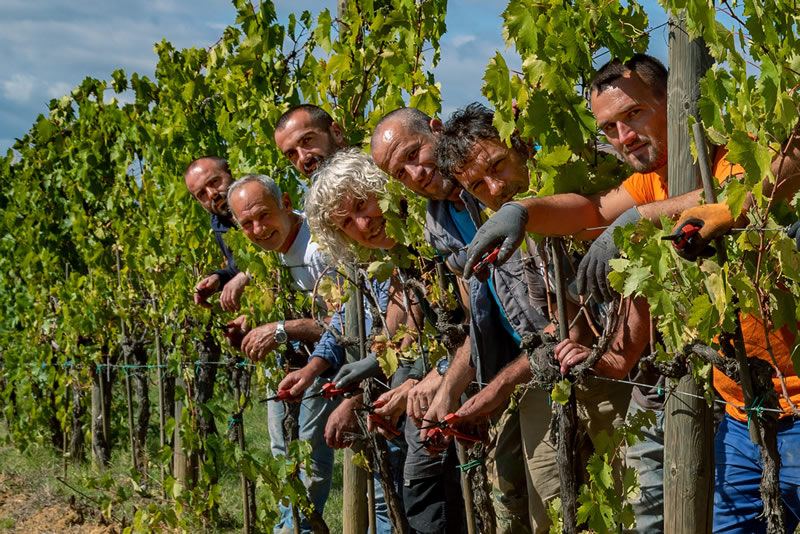HARVEST SPEED OR SELECTION OF GRAPES?
Optimizing harvesting speed is one of the reasons why some companies prefer to harvest using very fast machinery in optimal conditions. The reasons for this rush in collection are many, and in addition to the costs, also concern the climate, in particular the risk of frost, hail and rain.
HOW DOES THE MECHANICAL HARVEST WORK?
 Harvesting machines work” by shaking”: move the vines to cause the detachment of the berry.
Harvesting machines work” by shaking”: move the vines to cause the detachment of the berry.
Mechanical harvesting is a much more aggressive process than manual harvesting, and this has consequences: the must escapes from the berries and is exposed to oxidative phenomena, favoring fungi which could give wine organoleptic defects in the following phases.
Choose whether or not to use the harvesting machine also depends on the shape of vineyard itself.
In fact in many vineyards is not possible to use these machines.
• The harvesting machines cannot enter the rows easily considering the slope of the vineyards;
• The rows are too close;
• There are no access roads with machines so cumbersome;
• The height and type of poles for vineyards do not allow entry;
• Or also because grape berries resist shaking or the shoots are placed in such a way that they cannot be avoided.
We can therefore say that the results of a mechanical harvest depend on the type of harvesting, the type of soil, and the type of grapes.
In addition, the mechanical harvest does not allow the selection of the bunches but obviously brings them all in the cellar, and this point creates qualitative homogenization of the wine.
Intact berries and quality of wine
We say that using harvesting machine, the grapes are crushed more than the manual harvest, where onthe contrary, we cut cluster by cluster, we spin after row. The man’s hand is more delicate and precise, so the grapes arrive whole to the cellar.
After harvest, the bunches are placed in small cases for transport to the cellar. At this point the grapes are crushed by a mechanical crusher until must is obtained, which than follows all the further steps, from fermentation to aging. Crushing the grape berries during harvesting can affect the quality of the wine.
The manual harvesting guarantees greater control and quality of the wine, and we can say with conviction that, at least in this activity, the machines do not pass man’swork.
It is clear, however, that the manual harvest has either costs: it takes more time and more workers. Anyway, if you want to produce quality wines, the manual harvest remains the best choice.
When you taste wines, it is not easy to recognize how grapes were harvested, but one thing is certain: making wine is a tradition and a passion that must be respected in all its phases.

Our opinion remains that wine must be made with Our Hands, and these are Ours!!
Cantine Cantalici Shop Online
More products you may be interested...
Grappa of Vinsanto
Grappa of Vin Santo, Reserve, is a distilled product silky and soft with hints of raisins.
Rose' Wine IGT Petali
The ideal aperitif, but also excellent with fish, cold cuts and cheeses: our rosé wine is floral, fresh and vibrant.
Tangano - Tuscan IGT
The Tuscan IGT Tangano is an intense, vigorous and soft blend that gives its best combined with roasted and moist game.
Penne Pasta
Penne rigate, made with ancient wheat Saragolla, are excellent for light, simple sauces with a base of fresh tomatoes, such as the famous “all'arrabbiata” condiment.

"PSR 2014-2020 - Measure 4.1.3 PID 2019. Participation in integrated planning by agricultural companies."
Transformation/marketing of agricultural products: Buildings for the conservation/storage of primary and/or processed agricultural products (Buildings and masonry works). Renovation of the roof covering of the building located in the Municipality of Gaiole in Chianti Sheet 34, part. 122 subordinate 8, for a surface area equal to 1922 m²
(portion highlighted in the project)
Investment made with financing FEASR - CUP ARTEA: 1014205 - CUP cipe: D52H22000190007

"Measure 4.2.1 – GAL Siena – Investments in the transformation, marketing and/or development of agricultural products."
CELLAR MODERNATION: intervention carried out and co-financed with the contribution of the PSR 2014-2022 of the Tuscany Region - Measure 4.2.1. of the GAL Leader Siena
CUP ARTEA: 1245832 – CUP CIPE C55B24000230007

 The harvest period is a intense and tiring moment, because it involves many people, and must last short time, as it’s necessary to pick the grapes at the right time: when it has reached the optimum sugar level for the type of wine to be obtained, but before something spoils this state of grace, which allows to obtain quality wines.
The harvest period is a intense and tiring moment, because it involves many people, and must last short time, as it’s necessary to pick the grapes at the right time: when it has reached the optimum sugar level for the type of wine to be obtained, but before something spoils this state of grace, which allows to obtain quality wines.


